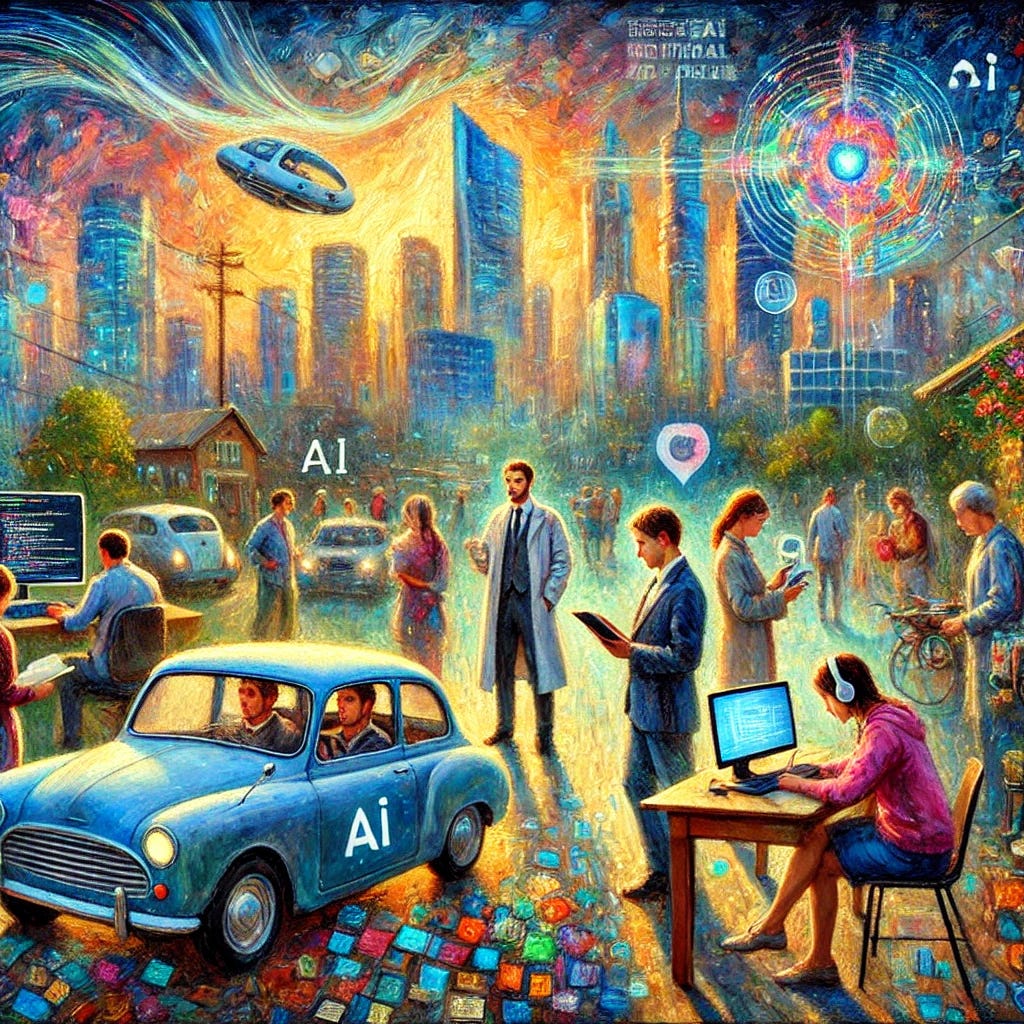Let me walk you through the world as it is — not as it was, and not quite as it will be.
Somewhere today, a teacher just shaved an hour off her prep time with an AI quiz maker. A marketer is still debating whether to trust the same technology that just helped a developer write cleaner code. And in China, a cancer patient just uploaded their medical file — not to a doctor, but to an AI trained by one. That conversation? It wasn’t with a human. But it may have saved their life.
We are surrounded by quiet revolutions.
GPT-4.1 now understands more than ever — long documents, complex instructions, even subtle reasoning. It doesn’t just process language; it shapes ideas. You’ll see it embedded in the background of your favorite apps, whispering answers before you even think to ask.
Yet not every upgrade is equal. One AI needed a minimap to beat another in a game of Pokémon. Cute, but misleading — and a reminder that progress without standards is just noise.
Meanwhile, celebrities are floating in space while others watch from Earth, unimpressed. It’s not that we don’t believe in the stars — we just want the journey there to mean something.
And in San Francisco, someone found love in the back seat of a robotaxi — with a handwritten note. A kind of analog rebellion, a soft counterbalance to the precision of our machines.
But for all this progress, risk hasn’t left the room. Ask the Hertz customers whose data just walked out the door through a third-party breach.
Still — innovation pushes forward. Finland’s building the biggest startup campus in Europe. Huawei is building chips that challenge the best in the world. Hugging Face just gave a robot a soul.
So what’s really happening?
The world isn’t becoming more digital.
It’s becoming more human, through technology.
And our job — your job — is to make sure the tools we build serve something bigger than convenience.
They should serve meaning. Connection. And maybe, if we get it right, a better version of ourselves. And you’ll keep discovering how, in THE COMUNICANO!!!
Andy Abramson
OpenAI Watch
OpenAI Introduces GPT-4.1 With Smarter Reasoning and Long-Term Memory (OpenAI.com)—GPT-4.1 has arrived with a fresh blend of scalability and finesse. It brings turbo-charged capabilities — smoother reasoning, better instruction following, improved tool usage, and an impressive ability to handle up to 1 million tokens in context. The new release promises enhanced accuracy and speed, now powering everything from ChatGPT to API integrations. With plans to sunset GPT-4.5 by July, OpenAI is clearly doubling down on making smarter AI more broadly accessible — and more useful than ever for everyday tasks. Read more here
OpenAI Rolls Out GPT-4.1 With Major Upgrades in Power and Precision (VentureBeat)—OpenAI’s GPT-4.1 models mark a leap forward, offering context windows up to 1 million tokens and sharper coding problem-solving skills. The upgrade includes GPT-4.1, Mini, and Nano — each model trimmed for different needs and priced more affordably than earlier iterations. With a 54.6 percent score on SWE-bench Verified, it’s now the best-performing LLM for real software engineering tasks. Instruction following, reasoning, and handling of long documents have all been fine-tuned. Enterprises, get ready — GPT-4.1 isn’t just bigger, it’s smarter and cheaper too. Read more here
OpenAI's GPT-4.1 Models Quietly Power Everyday Apps (TechRadar)—OpenAI's latest GPT-4.1 models are designed for seamless integration into various applications, making advanced AI capabilities more accessible than ever. These models, including GPT-4.1 Mini and Nano, are optimized for tasks like instruction-following, coding, and processing large amounts of information. As a result, users may find AI features embedded in tools like email clients, budgeting apps, or recipe managers without direct interaction with ChatGPT. This approach positions AI as a behind-the-scenes utility, enhancing user experiences subtly and efficiently. Read more here
OpenAI's GPT-4.1 Outperforms GPT-4.5 in Coding Benchmarks (Ars Technica)—OpenAI's latest model, GPT-4.1, has surpassed its predecessor, GPT-4.5, in coding benchmarks, achieving a 54.6% score on the SWE-bench Verified test compared to GPT-4.5's 38.0%. This improvement highlights GPT-4.1's enhanced capabilities in software engineering tasks. Despite the numerical naming suggesting a minor update, GPT-4.1 represents a significant advancement in AI performance. Read more here
AI Watch
AI Benchmarks Go Off the Rails with Pokémon Faceoff (TechCrunch)—An online claim that Google’s Gemini AI beat Anthropic’s Claude at playing old-school Pokémon turned into a full-blown AI benchmarking debate. The catch? Gemini had help — a custom minimap gave it a major advantage. The stunt has sparked pushback from researchers and developers, who argue the comparison was anything but fair. It’s a reminder that as fun as these AI head-to-heads may be, standards matter if we want useful evaluations. In the arms race of large language models, Pokémon might not be the right arena. Read more here
Ant Group Expands Healthcare Footprint with AI Doctors on Alipay (South China Morning Post) Ant Group is making a major play in digital healthcare by launching nearly 100 AI doctor agents on its Alipay platform. Each AI is trained by the team of a well-known Chinese physician, offering expertise in fields like oncology and chronic disease management. Users can chat with these AI doctors via text or audio, upload medical reports for real-time feedback, and even book follow-up consultations. This move underscores the rising popularity of AI-powered care in China and signals Ant’s deeper investment in the intersection of fintech and healthtech. Read more here
Marketers Grapple with AI Adoption Amid Trust and Skills Gaps (The Drum)—Despite AI's growing presence in marketing, many professionals remain hesitant to fully embrace it. Concerns over data privacy, ethical considerations, and a significant skills gap are major hurdles. The rapid evolution of AI technologies has outpaced the development of comprehensive training programs, leaving marketers feeling unprepared. Additionally, skepticism about AI's ability to replicate human creativity and the fear of job displacement contribute to the cautious approach. To move forward, the industry must address these challenges through transparent practices, targeted education, and a focus on augmenting rather than replacing human input. Read more here
Huawei Launches AI Architecture to Challenge Nvidia's Dominance (South China Morning Post)—Huawei has rolled out the CloudMatrix 384 Supernode, a powerful new AI infrastructure designed to compete with Nvidia’s NVL72 system. Delivering up to 300 petaflops of computing power — well above Nvidia’s 180 — the system represents a strategic push by Huawei to achieve high-performance AI computing without relying on U.S. technology. Already active in Huawei’s data centers in Wuhu, China, the CloudMatrix setup aims to tackle large-scale AI workloads and is pitched as a rival to Nvidia’s top-tier GPU clusters. It’s another move in China’s accelerating tech self-reliance drive. Read more here
EduTech Watch
Google Classroom Gets AI Quiz-Maker to Help Teachers Save Time (TechCrunch)—Google is bringing generative AI straight into the classroom. Teachers using Google Classroom can now input text or upload documents and get AI-generated quiz questions — tailored by topic, grade level, or format. The feature is part of Google Workspace for Education with the Gemini add-on. It’s a direct attempt to streamline prep work and lighten the load for educators. With AI stepping in to handle the busywork, teachers get to spend more time doing what matters most — actually teaching. Read more here
Privacy Watch
Hertz Data Breach Exposes Sensitive Customer Info, Including Licenses (TechCrunch)—Hertz has confirmed a major data breach that compromised customers’ personal and driver’s license information. The breach stems from a cyberattack on third-party vendor Cleo Communications, affecting data from late 2024. Info like names, contact details, license numbers, and even Social Security and passport info in some cases, was exposed. The Clop ransomware gang is claiming credit. Hertz is offering impacted customers two years of identity monitoring, but the incident is yet another example of how third-party weaknesses remain one of cybersecurity’s biggest cracks. Read more here
Startup Watch
Finland Eyes Europe’s Start-Up Crown with Maria 01 Expansion (BBC News)—Finland is making a serious play for the title of Europe’s start-up capital, and its bet is a major expansion of Helsinki’s Maria 01 campus. Housed in a former hospital, Maria 01 already supports 240 start-ups in health tech, AI, gaming, and cybersecurity. The goal is to grow into the largest start-up hub in Europe by 2028, adding 50,000 square meters and a new accelerator. Finland’s start-up ecosystem benefits from government support, global-friendly policies, and a wellness-focused lifestyle—but challenges remain. A recent VAT hike and stricter citizenship rules may cool some of the momentum. Read more here
Robot Watch
Hugging Face Acquires Pollen Robotics to Merge AI and Humanoids (TechCrunch)—Hugging Face has acquired French robotics company Pollen Robotics, creators of the open-source humanoid robot Reachy 2. This move marks Hugging Face’s leap into the physical AI world, expanding beyond software and into robotics. The robot’s code and design are available on GitHub, encouraging the developer community to experiment, improve, and push innovation forward. It’s a bold play to democratize robotics the same way Hugging Face did with natural language processing — making human-like machines a little more open and a lot more collaborative. Read more here
Space Watch
Celebrity Space Tourism Triggers Existential Eye Rolls (The Telegraph)—Blue Origin’s latest suborbital trip — featuring Katy Perry, Vanessa Kirby, and Lauren Sánchez — may have returned safely to Earth, but not everyone’s celebrating. Critics called it a tone-deaf flex, with social media skewering the event as billionaire space cosplay. For some, seeing celebrities float in zero gravity was less inspiring and more infuriating. As space travel gets increasingly privatized, the question resurfaces — is this the dawn of a new era or just the world’s most expensive photo op? Read more here
SportsTech Watch
Sports Teams Use Tech to Bring the Game to Low-Vision Fans (CNBC)—Stadiums are stepping up their accessibility game. From wearable devices delivering real-time audio descriptions to apps providing guided navigation and play-by-play detail, blind and low-vision fans are finally being included in the live sports experience. Some arenas are even rolling out tactile maps and better signage. It’s part of a larger push to make sports events inclusive for all — not just a win for accessibility, but a model for how tech can bring people closer to the action, no matter their vision. Read more here
Tracker Watch
Chipolo Pop Tracker Launches with Cross-Platform Bluetooth Tracking (Mashable)—Chipolo has launched the Chipolo Pop, a Bluetooth tracker that works with both Apple’s Find My and Google’s Find My Device networks — though only one at a time. It features a 300-foot Bluetooth range, 120dB alarm, and an IP55 rating for durability. The Pop is available in six colors and includes a user-replaceable CR2032 battery. Android users get extra perks like left-behind alerts and camera shutter control. It’s a clever, compact addition for folks who hate losing their stuff, now without the platform lock-in hassle. Read more here
Dating Watch
San Francisco Tech Workers Use Robotaxis for Handwritten Notes (Moneycontrol)—In San Francisco, tech workers are turning to an unconventional method of communication: leaving handwritten notes in autonomous robotaxis. One recruiter placed a job advertisement in a Waymo vehicle, resulting in over 60 applications. Another individual left a note seeking a romantic connection. These analog messages have gained significant attention online, highlighting a desire for more personal interactions in an increasingly digital world. Waymo has acknowledged these notes, stating they are proud to facilitate both personal and professional mobility. Read more here





